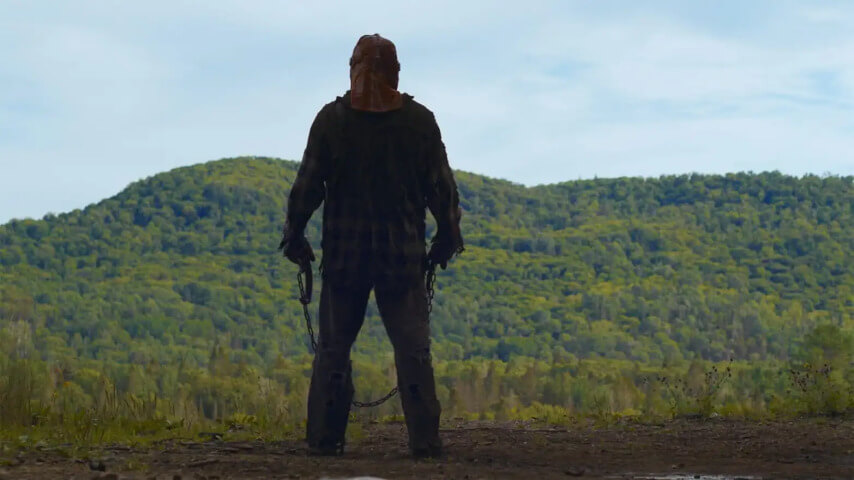Ever since Jason Voorhees skulked across Camp Crystal Lake, the slasher has long been obsessed with the aesthetic constraints of the forest, treating it as the basis for endless nightmarish scenarios. They are insulated hellscapes, places where gore and screams are absorbed. In slashers, death keeps the woods buzzing with anonymous life. Chris Nash’s feature film debut, In A Violent Nature, immediately involves the audience in the shifting mire of the slasher’s ecosystem, with its protagonist Johnny (Ry Barrett) crawling out from a layer of silt and dead leaves after a fairly innocuous conversation between disembodied voices (and the stealing of a cursed amulet, of course). It’s like the woods themselves are possessed, blurring the line between setting and characters–all of which is characteristic of Nash’s unusual filmmaking. Background bleeds into foreground, action into inaction, violence into natural serenity.
With such an unhurried outlook—one that remains unfailingly locked into the villain’s perspective—there is the potential for it to feel like a video game gimmick, but Nash teases out the cinematic value of this methodical vantagepoint. Any sense of being tricked is sidestepped by the director’s tight control of tone and space. Shots are painstakingly composed with long single takes, absorbing the sound of creaking boughs and snapping twigs with no interfering music, letting the patient spanning of the world around substitute the score.
As such, the thin veneer of plot that In A Violent Nature clings to feels starkly unnecessary, a frustrating distraction from the film’s delicate brutality. Johnny is searching for his lost amulet and in one (particularly forced) flashback, we learn it was passed on to him by his kind mother, who (as the film then explains) was a victim of cruel locals in decades past. The mysterious energy that otherwise holds the story together leaks out, and such an obvious explanation shatters its alluring, uncomfortable shape.
Usually, slashers operate best by efficiently conveying the contours of their victim’s lives, thereby making a case for any investment in the ensuing devastation. In Scream’s first scene, Casey Becker (Drew Barrymore, adorned with her iconic blonde bob), is wandering around her house, preparing for a night in. She is a quippy and thoughtful teenager, armed with a specific cultural vocabulary (“Well the first one was [scary], but the rest sucked!” she quickly surmises of the Nightmare on Elm Street series). Everything from Casey’s shade of dark lipstick, to her circling around the kitchen, instinctively picking up the salt shaker and fiddling with the block of knives, suggests a real person, with a life that expands further than the screen.
But In A Violent Nature abandons such a tone-setting tool, with the film’s victims mostly caught in brief, undefined flashes. Nash smartly blurs the group’s personalities together, creating a network of overlapping quips and retorts, where no one meaningfully stands out. Instead, the film imagines a more base way of hooking the audience. Through the escalating violence—culminating in one of the goriest kills ever preserved in film (you’ll know it when you see it)—Nash appeals to the purely physical sensation of witnessing death, employing a visceral, bodily empathy. Even if someone’s name or face remains unknown, the audience is immediately invested in their survival. In A Violent Nature proves that the relationship between character and viewer can transcend typical conceits to be wholly empowered by the simple question of “What would that feel like?”
The final scenes of In A Violent Nature stay true to the film’s rebellious nature, letting the din of chopping and sawing and blood-spattering peter off into the gentle rush of wind through trees. Tension ratchets up until it evaporates, floating away with nowhere to go. Gnawing dread bursts into acute pain, which slips into absence and emptiness; that is the structure of the kills and the only honest answer to the aforementioned question of what it would feel like to be on the receiving end of Johnny’s ruthless cruelty.
Despite occasionally straying into familiar territory, Nash and his collaborators spend an impressive amount of time slowly exploring the misunderstood mechanics of the slasher. With In A Violent Nature, Nash crafts something entirely new; composed, near and real. But the film’s sense of tone and timing prove that he also intimately understands why audiences were always invested in these marathons of blood, gore, and guts.









































